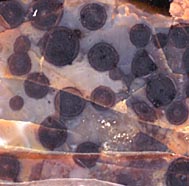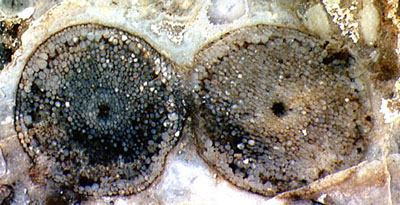Rhynia
In 1917, when a name had to be found for a fossil plant in
the Rhynie chert, Kidston
and Lang
chose Rhynia
Gwynne-Vaughani in honour of their deceased collegue,
Gwynne-Vaughan
[1]. They were not aware then that the
fossils did not represent one species
but two. They found out soon and
assigned
the name to the smaller one [2]. (Later, the spelling of the name was
slightly modified
into Rhynia
gwynne-vaughanii.) The bigger one got the name Rhynia major and
kept it
until 1984 when it was arguably re-named Aglaophyton
major [3]. Some confusion
apparently resulting from the repeatedly changing names is felt even
today.
If one sees a dozen or more rather well preserved circular
cross-sections on one square centimetre, with diameters of 1-2mm,
occasionally with a bump on the circumference, it is surely Rhynia.
 No other Rhynie chert plant offers such aspect.
No other Rhynie chert plant offers such aspect.
Image on the right: Rhynia
cross-sections on one
square centimetre of cut chert face.
 Image on the left:
Rhynia, cross-section
of forked shoot at a position where
the branches are not yet fully separated. (Forking at an acute angle
is not the only branching type observed
with Rhynia.)
Note also the well preserved
tissue.
Image on the left:
Rhynia, cross-section
of forked shoot at a position where
the branches are not yet fully separated. (Forking at an acute angle
is not the only branching type observed
with Rhynia.)
Note also the well preserved
tissue.
More often than any other species in the chert,
Rhynia is
seen with well preserved tissue. Like other
plants, Rhynia
is less easily recognized when
deformed or shrivelled. Seldom seen axes with wart-like bumps bearing
rhizoids seem to be rhizomes.
Rhynia
does not form arches to creep over
the ground as Aglaophyton
does. As another difference, symmetrical U-shaped branching, which is
typical for Aglaophyton
, is probably absent with Rhynia. Despite of
the differences, Aglaophyton
and Rhynia
are more similar to each other than to any other plant in the chert.
For contributions involving Rhynia see
Rhynie Chert News 4,
17, 19, 31, 32, 114, 127, 159
[1] R.
Kidston, W.H. Lang
: On Old Red Sandstone plants
showing structure from the Rhynie Chert Bed, Part I,
Trans. Roy. Soc. Edinburgh 51(1917),
761-84.
[2] R.
Kidston, W.H. Lang
: On Old Red Sandstone plants
showing structure from the Rhynie Chert Bed, Part II,
Trans. Roy. Soc. Edinburgh 52(1920),
603-27.
[3] David
S. Edwards,
Aglaophyton
major, a non-vascular
land-plant from the Devonian Rhynie Chert,
Bot. J. Linn. Soc. 93(1986), 173-204.
 No other Rhynie chert plant offers such aspect.
No other Rhynie chert plant offers such aspect. Image on the left:
Rhynia, cross-section
of forked shoot at a position where
the branches are not yet fully separated. (Forking at an acute angle
is not the only branching type observed
with Rhynia.)
Note also the well preserved
tissue.
Image on the left:
Rhynia, cross-section
of forked shoot at a position where
the branches are not yet fully separated. (Forking at an acute angle
is not the only branching type observed
with Rhynia.)
Note also the well preserved
tissue.